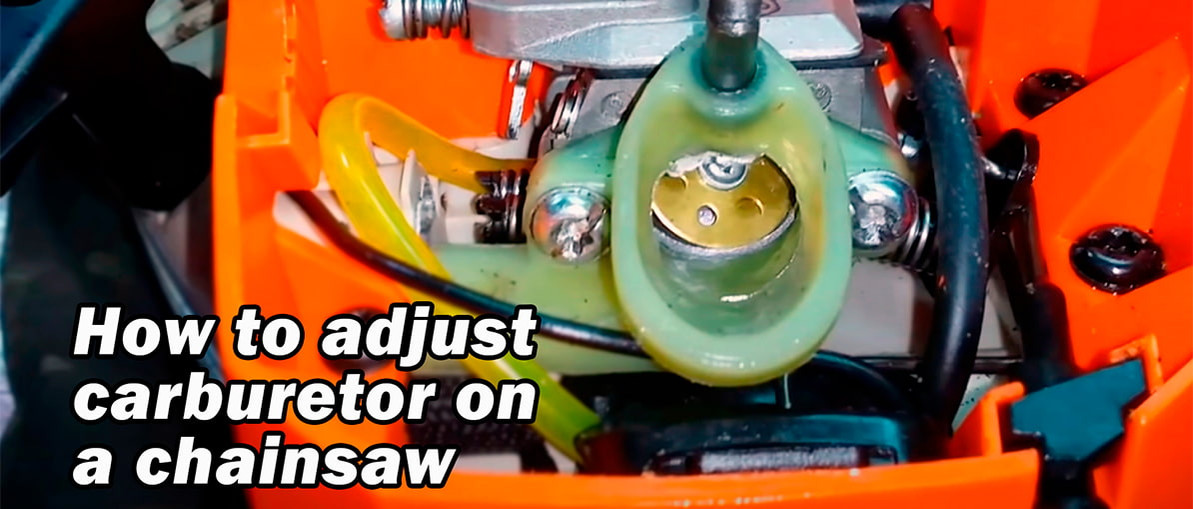How to Adjust Carburetor on a Chainsaw
If you own a chainsaw, you know how important it is to keep it running smoothly and efficiently. One key component of your chainsaw's engine is the carburetor. The carburetor is responsible for mixing air and fuel in the right proportions, ensuring that your chainsaw starts easily and runs smoothly. Over time, the carburetor may need adjustment to maintain optimal performance. In this blog post, we will guide you through the process of adjusting the carburetor on your chainsaw.
Before we begin, it's important to note that carburetor adjustment can vary depending on the make and model of your chainsaw. Always consult your chainsaw's manual for specific instructions. Additionally, if you are unsure about performing the adjustment yourself, it is best to seek professional assistance.
Now, let's dive into the step-by-step process of adjusting your chainsaw's carburetor:
Step 1: Safety First Before working on your chainsaw, make sure to wear appropriate safety gear, including goggles, gloves, and hearing protection. It's also a good idea to work in a well-ventilated area to avoid inhaling any fumes.
Step 2: Locate the Adjustment Screws The carburetor on most chainsaws has two adjustment screws: the low-speed screw and the high-speed screw. These screws are typically located on the side of the carburetor and can be identified by their small size and slotted heads.
Step 3: Prepare the Chainsaw Start by ensuring that your chainsaw is turned off and the engine is cool. Remove the air filter cover and the air filter to access the carburetor.
Step 4: Initial Settings Before making any adjustments, it's important to know the initial settings for the low-speed and high-speed screws. Consult your chainsaw's manual for these settings, as they can vary.
Step 5: Adjust the Low-Speed Screw To adjust the low-speed screw, turn it clockwise until it lightly seats, then turn it counterclockwise the specified number of turns as per your chainsaw's manual. This is usually around 1 to 1.5 turns. This initial setting will provide a good starting point for further adjustment.
Step 6: Adjust the High-Speed Screw Similar to the low-speed screw, turn the high-speed screw clockwise until it lightly seats, then turn it counterclockwise the specified number of turns as per your chainsaw's manual. This initial setting is typically around 1 to 1.5 turns.
Step 7: Fine-Tuning With the initial settings in place, you can now fine-tune the carburetor. Start the chainsaw and let it warm up for a few minutes. Then, using a small screwdriver, adjust the low-speed screw to achieve smooth idling. Turn the screw clockwise to increase the idle speed and counterclockwise to decrease it. Aim for a steady idle without the chain moving.
Next, rev the chainsaw to full throttle and listen to the engine's sound. If it sounds too lean (a high-pitched whine), turn the high-speed screw counterclockwise in small increments until the sound becomes richer. If it sounds too rich (a heavy, bogging sound), turn the high-speed screw clockwise in small increments until the sound becomes crisper and cleaner.
Step 8: Test and Repeat After making adjustments, test your chainsaw's performance by cutting a small piece of wood. Observe how the chainsaw starts, accelerates, and runs. If necessary, make further adjustments to achieve optimal performance. Remember to make small changes and test each time to avoid damaging the engine.
Step 9: Maintenance and Cleaning Regular maintenance and cleaning of the carburetor are essential to keep your chainsaw running smoothly. Consult your chainsaw's manual for instructions on how to clean and maintain the carburetor properly.
In conclusion, adjusting the carburetor on your chainsaw is an important task to ensure its optimal performance. However, if you are unsure or uncomfortable performing the adjustment yourself, it is always best to seek professional assistance. At Chainsawparts, we are experts in the chainsaw parts industry with over 50 years of experience in the landscaping industry. If you have any doubts or need assistance, feel free to reach out to us through our Contact Us URL.
Remember, maintaining your chainsaw regularly and using high-quality replacement parts are key to its longevity and efficiency. If you need any replacement parts for your chainsaw, use our parts lookup URL or simply search for the specific part you need using our search bar. We offer a wide range of original replacement parts for chainsaw equipment, ensuring that you get the best quality and performance for your chainsaw.
Happy chainsawing!
Recent Posts
-
How to Fix a Stretched Chainsaw Chain
When it comes to maintaining your chainsaw equipment, one of the common issues you may encounter is …Aug 21st 2024 -
How To Adjust The Idle On A Husqvarna Chainsaw
Adjusting the idle on your Husqvarna chainsaw is an essential maintenance task that ensures opt …Aug 7th 2024 -
How To Clean Chainsaw Filter
When it comes to maintaining your chainsaw, one of the most crucial tasks is cleaning the chai …Jul 31st 2024

